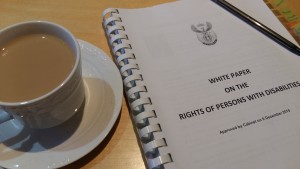Disability Rights : A huge step forward!
There has been much talk recently about our rights; women’s rights, religious rights, children’s rights, civil rights, gay rights and more, sparked by events both in South Africa and abroad.
A landmark event in South Africa during December has similarly created a wave of excitement and discussion amongst individuals and organisations alike within the disability sector. Sadly, the greater public is unaware of this, although they are directly affected.
I am speaking of the approval by Cabinet on 9 December 2015 of the White Paper on the Rights of Persons with Disabilities (WPRPD).
So why is this such an enormous event for persons with disabilities? Don’t all South Africans enjoy equal rights? Well, yes and no. On paper, all South Africans are equal before the law, as stipulated in Chapter 2 of our constitution, the Bill of Rights, including persons with disabilities. South Africa has fantastic legislation which protects the rights of all its citizens, and persons with disabilities are included. We also have the Integrated National Disability Strategy (INDS) which detailed our strategy when dealing with persons with disabilities, the Technical Assistance Guidelines (TAG) which lists case studies on accommodation persons with disabilities in employment, and many others. However, these have simply been strategies and guidelines, with no real bite.
Up until now. The White Paper is the forerunner of what is hoped will be a Bill and subsequently formulated into legislation. Now we’re moving forward. Now we have a document that will fast track transformation regarding persons with disabilities.
The White Paper was developed over a period of time in consultation with organisations of and for persons with disability, State Departments, The South African Human Rights Commission and more that brings the United Nations Convention on the Rights of Persons with Disabilities closer to home and guides the review of existing policies and development of new policies to align with international treaty obligations. It also stipulates the norms and standards for the removal of barriers that maintain the discrimination against persons with disabilities and outlines the responsibilities of stakeholders in providing barrier-free, appropriate service delivery to persons with disabilities.
To this end, the White Paper if based on 9 strategic pillars, each broken down into focus areas and accompanied by an Implementation Matrix that unpacks the pillars into measurable and time-based actions.
That’s great, you say, but what does it have to do with me?
Well, you have an important role to play in embracing disability and the people who are affected by disability. Most barriers are put in place through negative attitudes and attitudes can be changed through education. Any person with a disability will tell you that they continue to experience discrimination on a daily basis. Whether it’s the announcements at the train station that one is unable to hear, the teller at the bank who refuses to assist a client with a visual impairment, the accessible toilet which is locked and nobody knows where to find the key, or the rude stares from people as you pass by, the person on the receiving end gets the clear message that they are a nuisance and not welcome.

YOU have the power to change that, within your own circle. You can be the change in your family, your neighbourhood, worship group, book club, sports team and many others. By changing your own attitude, you will be a catalyst of change amongst all who come into contact with you.
Will you take up the challenge? Will you get involved in driving the change that is taking place right now for persons with disabilities?


